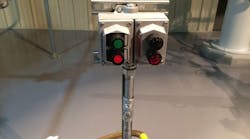Nearly all petrochemical facilities and refineries have tank farms that store feedstock or end products. The tank farms are almost always contained within diked areas. If the tank contains volatile components such as oil, gasoline, etc., then the area around the tank and within the diked area are considered to be a hazardous (classified) location as noted by the American Petroleum Institute, Recommended Practice 500 and National Fire Protection Association 497. The area immediately adjacent to the tanks is typically classified as Class I, Div. 2 to a distance of 10 ft from the tank. This classified area also extends from the tank to the dike from grade level up to the height of the dike. Any underground trenches or sumps within this area are considered to be classified as Class I, Div. 1 locations. However, there are National Electrical Code (NEC) requirements for conduit sealing that can affect underground conduit runs.
As noted in NEC Art. 515, tank farms are known as “Bulk Storage Plants.” NEC Sec. 515.9 contains specific requirements for conduit sealing. The second sentence in Sec. 515.9 states, “…Buried raceways and cables under defined Class I locations shall be considered to be with a Class I, Division 1 or Zone 1 location.” It isn’t unusual to have underground conduits entering the diked area. The conduits can serve lighting for the tank or power and controls for valve actuator motors, for example.
The rub comes in placing the conduit seals in the correct location. A conduit seal is required before the conduit goes underground near the tank, as the conduit is crossing from a Class I, Div. 2 area into a Class I, Div. 1 area. It isn’t the intent of NEC Sec. 501.15 to install another conduit seal underground where the conduit goes beneath the dike. Conduit seals should never be placed in an inaccessible location, such as buried underground. However, as soon as the conduit resurfaces outside the dike, another conduit seal should be installed as the first fitting in the conduit run.
The Photo (courtesy of Eaton Crouse Hinds) shows a typical hazardous area control station with a conduit seal below.
© 2014 Fluor Corporation. All Rights Reserved.



